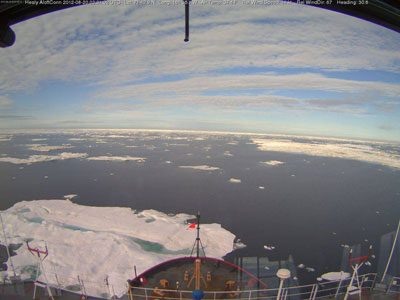Media Advisory: Arctic sea ice breaks lowest extent on record
The National Snow and Ice Data Center (NSIDC) is part of the Cooperative Institute for Research in Environmental Sciences at the University of Colorado Boulder. NSIDC scientists provide Arctic Sea Ice News & Analysis content, with partial support from NASA.
Arctic sea ice cover melted to its lowest extent in the satellite record yesterday, breaking the previous record low observed in 2007. Sea ice extent fell to 4.10 million square kilometers (1.58 million square miles) on August 26, 2012. This was 70,000 square kilometers (27,000 square miles) below the September 18, 2007 daily extent of 4.17 million square kilometers (1.61 million square miles).

Scattered ice floes are seen from the bridge of the USCGC Healy on August 20, 2012 northwest of Barrow, Alaska. Arctic sea ice fell to its lowest daily extent in the satellite record on Sunday, August 26, 2012.
NSIDC and NASA scientists will host a media teleconference today, August 27, at 1 p.m. MDT/3 p.m. EDT, to discuss this new record low Arctic sea ice extent.
NSIDC scientist Walt Meier said, "By itself it's just a number, and occasionally records are going to get set. But in the context of what's happened in the last several years and throughout the satellite record, it's an indication that the Arctic sea ice cover is fundamentally changing."
According to NSIDC Director Mark Serreze, "The previous record, set in 2007, occurred because of near perfect summer weather for melting ice. Apart from one big storm in early August, weather patterns this year were unremarkable. The ice is so thin and weak now, it doesn't matter how the winds blow."
"The Arctic used to be dominated by multiyear ice, or ice that stayed around for several years," Meier said. "Now it's becoming more of a seasonal ice cover and large areas are now prone to melting out in summer."
With two to three weeks left in the melt season, NSIDC scientists anticipate that the minimum ice extent could fall even lower.
In 2007, Arctic sea ice extent reached an all-time low in the satellite record that began in 1979. Arctic sea ice follows an annual cycle of melting through the warm summer months and refreezing in the winter. While Arctic sea ice extent varies from year to year because of changeable weather conditions, ice extent has shown a dramatic overall decline over the past thirty years. The pronounced decline in summer Arctic sea ice over the last decade is considered a strong signal of long-term climate warming.
Source: U. S. National Snow and Ice Data Center
- 348 reads
Human Rights
Ringing FOWPAL’s Peace Bell for the World:Nobel Peace Prize Laureates’ Visions and Actions

Protecting the World’s Cultural Diversity for a Sustainable Future

The Peace Bell Resonates at the 27th Eurasian Economic Summit

Declaration of World Day of the Power of Hope Endorsed by People in 158 Nations

Puppet Show I International Friendship Day 2020

